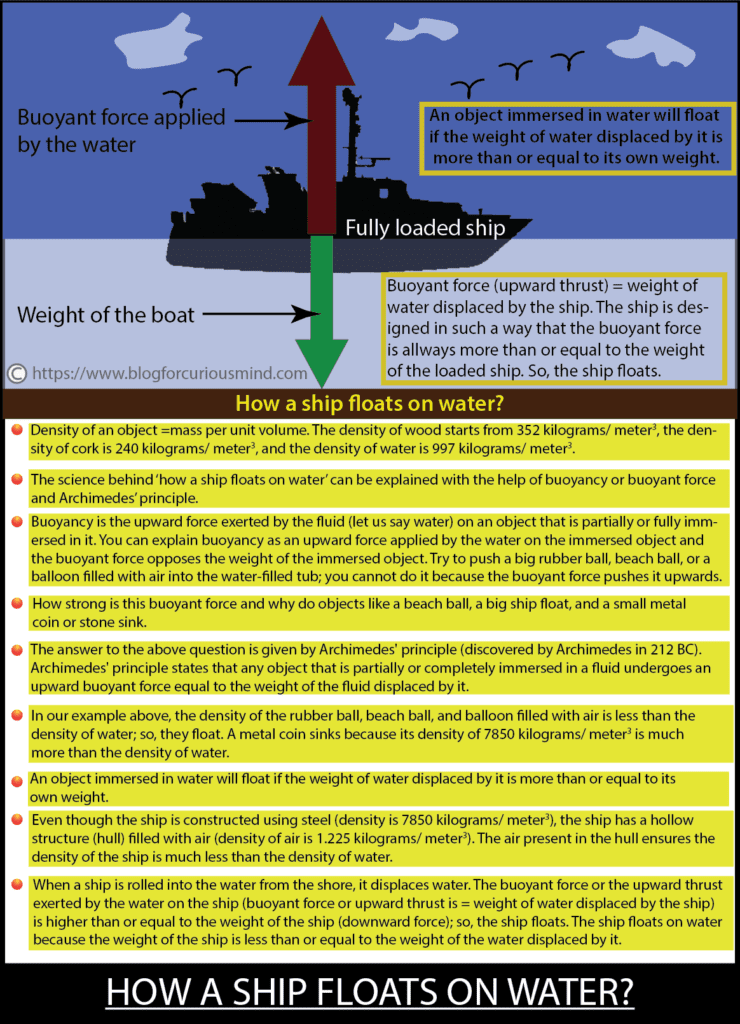Introduction
As children, we had wondered how a ship weighing thousands of tons floats on water but a small one-rupee metal coin sinks. Note that the ship as well as the coin are made of steel. As you studied science in school you have understood the reasons why this wonder happens.
This article is for people who might have forgotten the science studied in school (we all forget unless we revisit it once again to make our children understand it) and can be a review for others.

How a ship float on water?
Before going into the question of ‘how a ship floats on water‘ it is important to understand the concept of density. You can define the density of an object =mass per unit volume and the unit of volume can be a cubic meter (meter3), cubic feet (feet3), etc.
The density of wood starts from 352 kilograms/ meter3, the density of cork is 240 kilograms/ meter3, and the density of water is 997 kilograms/ meter3.
The science behind ‘how a ship floats on water’ can be explained with the help of buoyancy or buoyant force and Archimedes’ principle.
Buoyancy is the upward force exerted by the fluid (let us say water) on an object that is partially or fully immersed in it. You can explain buoyancy as an upward force applied by the water on the immersed object. The buoyant force opposes the weight of the immersed object.
Try to push a big rubber ball, beach ball, or a balloon filled with air into the water-filled tub. You cannot do it because the buoyant force pushes it upwards.
How strong is this buoyant force and why do objects like a beach ball, a big ship float, and a small metal coin or stone sink.
The answer to the above question is given by Archimedes’ principle (discovered by Archimedes in 212 BC). Archimedes’ principle states that any object that is partially or completely immersed in a fluid undergoes an upward buoyant force equal to the weight of the fluid displaced by it. In other words, the buoyant force will support an object if its density is less than the density of the fluid (in which the object is immersed).

In our example above, the density of the rubber ball, beach ball, and balloon filled with air is less than the density of water; or the weight of the water displaced by these objects is more than or equal to their own weight, so they float. A metal coin sinks because its density of 7850 kilograms/ meter3 is much more than the density of water.
An object immersed in water will float if the weight of water displaced by it is more than or equal to its own weight.
Even though the ship is constructed using steel (density is 7850 kilograms/ meter3), the ship has a hollow structure (hull) filled with air (density of air is 1.225 kilograms/ meter3). The air present in the hull ensures the density of the ship is much less than the density of water.
When a ship is rolled into the water from the shore, it displaces water. The buoyant force or the upward thrust exerted by the water on the ship (buoyant force or upward thrust is = weight of water displaced by the ship) is higher than or equal to the weight of the ship (downward force); so, the ship floats. The ship floats on water because the weight of the ship is less than or equal to the weight of the water displaced by it.
View You Tube Video 1 and Video 2.
Design and construction of boat or ship
The designer of the boat or ship should ensure that when the boat/ship (with its designed load) is immersed in water, the weight of the displaced water is more than the weight of the boat/ship.
The design of the hull is an important part of boat/ship design since it plays a crucial role in ensuring the safe movement of the boat/ship in the water. The hull consists of hollow shells made of steel or other material. The hollow structure of the hull filled with air makes the boat/ship less dense than water and this is why it floats.
The density of a fully loaded boat/ship (filled with crew, cargo, or passengers) should be much less than the density of water, to enable the boat/ship to float.
Application of buoyancy to equipment other than boat
The principle of buoyancy is used in equipment like life jackets, swimming aids, and life buoys.
Life jackets
When you travel by boat or when you hire a small boat for your personal use on public water, the local law stipulates mandatory wearing of life jackets.
Life jackets are air-inflated vests you wear on your apparel. In case of emergency, you can jump into the water, and the air-filled life jacket will keep you floating in the water till the arrival of the rescue team.
Swimming aids
If you go to a swimming school to learn to swim, they may give you swim learning aids like an air-filled circular rubber tube. The air-filled rubber tube wound around your waist will keep you floating in the water and while in water you can practice the swimming strokes (movements of hands and legs) to learn swimming.
In the olden days, village elders used to tie a low-density wooden piece to the back of the young boys/girls and make them practice swimming strokes in a well. The low-density wooden piece will keep the boy/girl floating in the well and allow him/her to learn swimming strokes.
Lifebuoys
These are circular rubber tubes filled with air. In case of emergency, it is thrown into the water to help a drowning person to provide him/her buoyancy. Lifebuoys are painted with visible colors and lights to easily find the location of the person to be rescued.
Frequently Asked Questions (FAQ)
Steel coin sinks in water but a steel boat/ship floats, why?
An object floats in water if its density is less than the density of water. So, objects made of wood (density starts from 352 kilograms/ meter3), and cork (density 240 kilograms/ meter3) float on water (density of water is 997 kilograms/ meter3), and a solid metal coin (density of 7850 kilograms/ meter3) sinks.
Even though the ship is constructed using steel (density is 7850 kilograms/ meter3), the ship has a hollow structure (hull) filled with air (density of air is 1.225 kilograms/ meter3). The air present in the hull ensures the density of the ship is much less than the density of water. Hence, a steel boat or ship floats on water.
Why do objects like a big piece of wood and cork float in water and a small metal coin sink?
The explanation for why some objects float on water and some sink can be the density of the object. The density of wood starts from 352 kilograms/ meter3, the density of cork is 240 kilograms/ meter3, and they are much less than the density of water 997 kilograms/ meter3.
The objects made of wood and cork are less dense than water, so, they float in water; it does not matter how small or how big these objects are. On the other hand, the density of the solid metal coin is 7850 kilograms/ meter3, and this is much more than the density of water; hence the coin sinks in water.
You may read the following articles
How a submarine sinks and floats on water
Parts of a boat and anatomy of a boat
Conclusion
The science behind ‘how a ship floats on water’ is very interesting. Hope this article has provided a satisfactory answer to this question and it was helpful to you.
References

